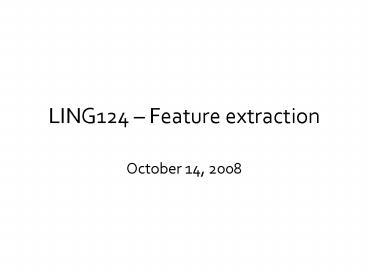LING124 Feature extraction PowerPoint PPT Presentation
1 / 13
Title: LING124 Feature extraction
1
LING124 Feature extraction
- October 14, 2008
2
Class outline
- Feature extraction (Front-end)
- Pre-emphasis
- Framing and windowing
- Mel-Frequency Cepstral Coefficients
- MFSC, MFCC
- Deltas, double-deltas
- Typical feature parameters
3
Feature extraction
- Capture essential acoustic information for speech
recognition
4
Pre-emphasis
- Increase the magnitude of some range of
frequencies with respect to other frequencies - Voiced part of the speech signal is often in high
frequency range, but high frequency formants have
smaller amplitude than low frequency formants - So we apply high-pass filter to speech signal
before we extract any acoustic features
5
Pre-emphasis (2)
- FIR high-pass filter
- yn xn-axn-1
- 0.9 a 1.0
6
Framing Windowing
- Divide speech signal into successive overlapping
frames - Frame-size 10 25 milliseconds
- Frame-shift 5 10 milliseconds
- Multiply individual frames by a specific window
function - Hanning window (Nnumber of samples in frame)
7
Spectrum
- Spectrum represents frequency components of
speech signal - Spectrum is derived by applying (discrete)
Fourier transform to a windowed segment of speech
signal
8
Mel-Frequency Spectral Coefficients
- Perception of pitch is semi-logarithmic
- Recall mel scale and bark scale
- Frequency-dependent smearing
- Ignore distinction that depends on difference
between two frequencies that are less than 90-120
mels apart - Break the spectrum into bands of equal mel
interval (90 mels) - Weighted average of spectral coefficients in each
band - The log of resulting band averages comprise the
Mel-Frequency Spectral Coefficients (MFSC)
9
Mel filter bank
- Each filters center frequency follows the
mel-scale - mel(frequency) 2595 log10(1frequency/700)
- The edges of a filter coincide with the center
frequencies of adjacent filters - maxFreq has to be lower than the Nyquist frequency
10
Mel filter-bank processing
11
Mel-Frequency Cepstral Coefficients
- Discrete Cosine Transform of MFSC
- Represents a signal as a sum of cosine functions
- cf. DFT uses both sine and cosine functions
- This can be interpreted as applying inverse
discrete Fourier transform to MFSC
12
Delta, double-delta
- Mel-frequency cepstral coefficients do not
include temporal information - How spectral shape changes over time is useful in
speech recognition - As we normally calculate velocity and
acceleration, we use first-derivatives (deltas)
and second-derivatives (double-deltas) of MFCCs
for temporal information
13
Typical feature parameters
- Pre-emphasis coefficient 0.97
- Frame-size 25ms
- Frame-shift 10ms
- 12 MFCC and log-energy
- Deltas, double-deltas
- A feature vector of 39 components

